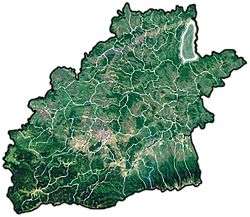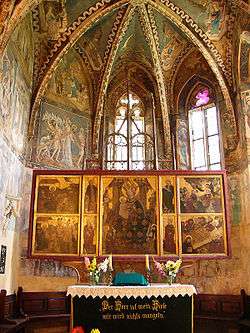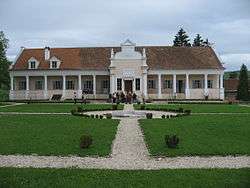Laslea
| Laslea | |
|---|---|
| Commune | |
|
Apafi manor in Mălâncrav | |
 Location of Laslea | |
 Laslea Location of Laslea | |
| Coordinates: 46°13′N 24°39′E / 46.217°N 24.650°E | |
| Country |
|
| County | Sibiu County |
| Population (2011)[1] | 3,248 |
| Time zone | EET (UTC+2) |
| • Summer (DST) | EEST (UTC+3) |
Laslea (German: Grosslasseln; Hungarian: Szászszentlászló) is a commune located in Sibiu County, Romania. It is composed of five villages: Florești, Laslea, Mălâncrav, Nou Săsesc and Roandola.
At the 2011 census, 61% of inhabitants were Romanians, 30% Roma, 7.5% Germans and 1% Hungarians. At the 2002 census, 76.2% were Romanian Orthodox, 7.2% Pentecostal, 5.7% Evangelical Lutheran, 5.2% Seventh-day Adventist, 2.6% Evangelical Church of Augustan Confession and 1.2% Baptist.

Villages
| In Romanian | In German | In Hungarian |
|---|---|---|
| Florești | Felsendorf | Földszin |
| Laslea | Grosslasseln | Szászszentlászló |
| Mălâncrav | Malmkrog | Almakerék |
| Nou Săsesc | Neudorf | Apaújfalu |
| Roandola | Rauthal | Rudály |
Mălâncrav is a village in Laslea commune. An asphalt road of 13 km leads to the village. In the village there is a small community of Transylvanian Saxons.
Here some of the most significant Gothic murals in Transylvania aside from those at Ghelința in Covasna County are found.
The Saxon Romanesque Lutheran church has early 14th-century Gothic murals in the apse. 15th-century ones are found in the nave and a 15th-century late Gothic altar.
In later centuries the Apafi family (Hungarian nobles in Transylvania) buried their dead in the church since they had overlordship in the village. Although the sarcophagi were removed (one of Mihaly Apafi is now in Budapest's Hungarian National Museum). The locality was not part of the autonomous Saxon territory Although until the 1970s when it was populated by Germans.
Prince of Wales and sustainable tourism
In 2006, The Prince of Wales bought and restored two 18th century Transylvanian Saxon houses in the villages of Mălâncrav and Viscri to help protect the unique way of life that has existed for hundreds of years and promote sustainable tourism.
The buildings have been sensitively restored and converted into guesthouses for tourists. They remain in keeping with the surrounding architecture and feature a number of Transylvanian antiques but with modern facilities where possible.
The renovation of these buildings has helped provide a sustainable future for the people of rural Transylvania while also enabling residents to maintain their traditional way of life.
Mălâncrav church gallery
 Exterior
Exterior 15th-century altar
15th-century altar The apse
The apse Mark the Evangelist
Mark the Evangelist Murals
Murals Jesus with the Cross on the Via Dolorosa
Jesus with the Cross on the Via Dolorosa Holy Hungarians, Bishop Gellert, Ladislaus I of Hungary, Unknown, Stephen I of Hungary, his son Holy Prince Emericus
Holy Hungarians, Bishop Gellert, Ladislaus I of Hungary, Unknown, Stephen I of Hungary, his son Holy Prince Emericus Mural, Hanging of Judas
Mural, Hanging of Judas Murals
Murals Murals, the Last Supper and Christ washing the apostles' feet
Murals, the Last Supper and Christ washing the apostles' feet
Coordinates: 46°13′N 24°39′E / 46.217°N 24.650°E
References
- ↑ Romanian census data, 2011; retrieved on March 15, 2012

